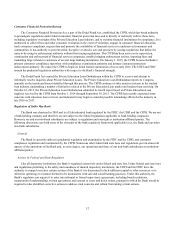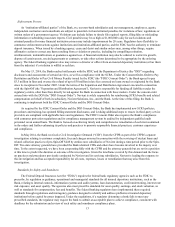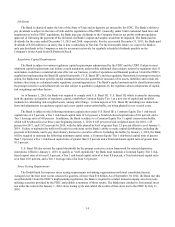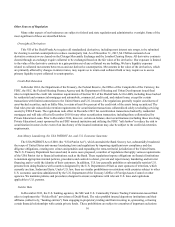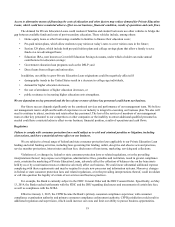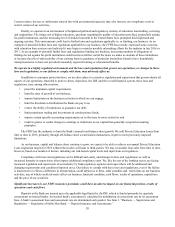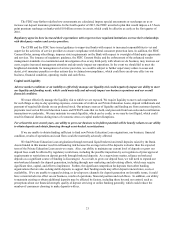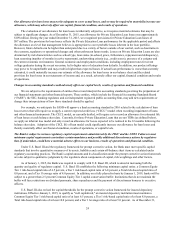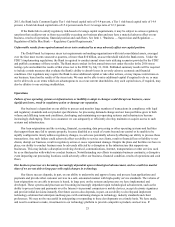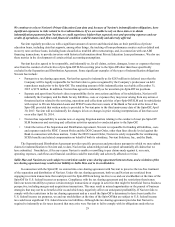Sallie Mae 2015 Annual Report Download - page 23
Download and view the complete annual report
Please find page 23 of the 2015 Sallie Mae annual report below. You can navigate through the pages in the report by either clicking on the pages listed below, or by using the keyword search tool below to find specific information within the annual report.21
The FDIC may further redefine how assessments are calculated, impose special assessments or surcharges on us or
increase our deposit insurance premiums. In the fourth quarter of 2015, the FDIC unveiled a plan that would impose a 4.5 basis
point premium surcharge on banks with $10 billion or more in assets, which could be effective as early as the first quarter of
2016.
Regulatory agencies have increased their expectations with respect to how regulated institutions oversee their relationships
with third-party vendors and service providers.
The CFPB and the FDIC have issued guidance to supervised banks with respect to increased responsibilities to vet and
supervise the activities of service providers to ensure compliance with federal consumer protection laws. In addition, the FDIC
Consent Order, among other things, imposes strict requirements on the Bank with respect to oversight of third-party agreements
and services. The issuance of regulatory guidance, the FDIC Consent Order, and the enforcement of the enhanced vendor
management standards via examination and investigation of us or any third-party with whom we do business, may increase our
costs, require increased management attention and adversely impact our operations. In the event we should fail to meet the
heightened standards for management of service providers, we could be subject to further supervisory orders to cease and
desist, civil monetary penalties or other actions due to claimed noncompliance, which could have an adverse effect on our
business, financial condition, operating results and cash flows.
Capital and Liquidity
Adverse market conditions or an inability to effectively manage our liquidity risk could negatively impact our ability to meet
our liquidity and funding needs, which could materially and adversely impact our business operations and our overall
financial condition.
We must effectively manage the liquidity risk to which we are exposed. We require liquidity to meet cash requirements
for such things as day-to-day operating expenses, extensions of credit on our Private Education Loans, deposit withdrawals and
payment of required dividends on our preferred stock. Our primary sources of liquidity and funding are from customer deposits,
payments received on Private Education Loans and FFELP Loans that we hold, and proceeds from loan sales and securitization
transactions we undertake. We may maintain too much liquidity, which can be costly, or we may be too illiquid, which could
result in financial distress during times of economic stress or capital market disruptions.
For at least the next several years, our ability to grow our business to its fullest potential will be heavily reliant on our ability
to obtain deposits and obtain financing through asset-backed securitizations.
If we are unable to obtain funding sufficient to fund new Private Education Loan originations, our business, financial
condition, results of operations and cash flows could be materially adversely affected.
We fund Private Education Loan originations through term and liquid brokered and retail deposits raised by the Bank.
Assets funded in this manner result in refinancing risk because the average term of the deposits is shorter than the expected
term of the Private Education Loan assets we create. Also, our ability to maintain our current level of deposits or grow our
deposit base could be affected by regulatory restrictions, including the possible imposition by our regulators of prior approval
requirements or restrictions on deposit growth through brokered deposits. As a supervisory matter, reliance on brokered
deposits as a significant source of funding is discouraged. As a result, to grow our deposit base, we will need to expand our
non-brokered channels for deposit generation, including through new marketing and advertising efforts, which may require
significant time, capital, and effort to implement. Further, the significant competition for deposits from other banking
organizations that are also seeking stable deposits to support their funding needs may affect deposit renewal rates, costs or
availability. If we are unable to expand existing, or develop new, channels for deposit generation on favorable terms, it could
have a material adverse effect on our business, results of operations, financial position and cash flows. In addition, our ability
to maintain existing or obtain additional deposits may be affected by factors, including those beyond our control, such as
perceptions about our financial strength, quality of deposit servicing or online banking generally, which could reduce the
number of consumers choosing to make deposits with us.



